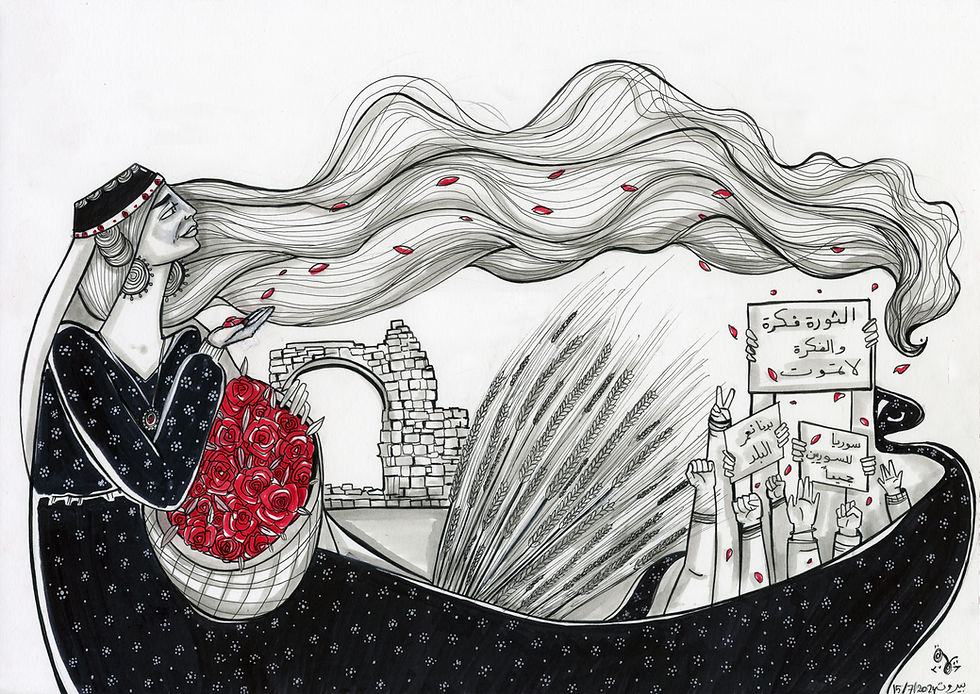Syrian Women: Negotiating Freedoms and Social Heritage
- adalaty
- Jul 16, 2024
- 3 min read
Updated: Aug 12, 2024
By: Maysoun Mohammed, lawyer and researcher specializing in women's issues.

Drawing by Dima Nachawi, Syrian artist.
The issue of women's liberation in Syria is among the most complex and sensitive, intertwining social, religious, and cultural aspects into a nuanced reality demanding deep, comprehensive understanding. Throughout history, Syrian women have faced multifaceted constraints imposed by social customs, traditions, and sometimes misinterpretations of religious doctrines, which have been used to justify these restrictions. Even with the onset of the Syrian revolution in 2011, women found themselves amidst a struggle for their rights and freedoms.
Social Constraints and Traditions
Like other Arab societies, Syrian society is entrenched in customs and traditions that assign specific roles to women. These roles often confine them to household duties and childcare, limiting their access to education, employment, and active participation in public life. These customs were not merely social practices but were often treated as quasi-sacred, making change challenging.
In many rural areas, girls are forced into early marriages under the guise of "protection," depriving them of education, work opportunities, and personal development. Married women face societal pressures to maintain marriages at any cost, hindering their personal and professional independence. The fear of divorce, stigmatised in many communities, further restricts their choices, often trapping them in unhealthy relationships due to economic dependence post-separation.
Religious Interpretations
Religiously, strict interpretations of Islamic law have at times justified the oppression of women, despite Islam granting significant rights to women in education, work, and social spheres. This regressive understanding often clashes with progressive interpretations advocating for women's rights and liberation from societal constraints. For instance, in some communities, the right to education is used as a tool for gender discrimination, where women face difficulties in accessing the same educational opportunities available to men.
Examples of Resistance
Despite challenges, women in Syria have begun challenging these norms, boldly advocating for their rights. Women's movements have emerged, aiming to raise awareness about women's rights, promote education, and increase participation in the workforce. Despite facing resistance from conservative forces determined to preserve the status quo, women have persisted in their struggle, organising workshops and social initiatives to enhance their skills, and engaging in political and social activism to reform discriminatory laws. In doing so, they have transformed personal challenges into sources of inspiration for many, strengthening the women's and feminist movements in Syria and driving towards genuine and sustainable change in society.
Revolution and Active Participation
During the Syrian revolution, women actively participated in protests, civil activities, and humanitarian efforts, demonstrating their capability to shoulder responsibilities in crisis situations. This active involvement challenged traditional norms and showcased women's contributions to rebuilding Syria's future. The journey for Syrian women has been fraught with challenges. Ideological divisions between secular and religious perspectives have become increasingly pronounced, complicating the discourse on women's liberation. Some women have chosen to remove their hijabs as a symbol of freedom from traditional constraints, while others have opted to wear them as an expression of their religious and cultural identity. These personal choices have ignited widespread debate and elicited diverse reactions from various factions, highlighting the profound and interwoven challenges that women in Syria face. These divisions underscore the intricate nature of the Syrian context, where cultural, religious, and social factors converge to create a complex reality that demands nuanced and comprehensive understanding.
Toward Comprehensive Liberation
Achieving women's liberation in Syria requires addressing cultural, religious, and social factors that restrict women's rights. A comprehensive approach should acknowledge diverse identities and perspectives, balancing cultural and religious preservation with women's rights. Collaboration among societal, religious, and political entities is essential to finding solutions that foster liberation and justice.
In conclusion, the liberation of Syrian women is integral to the broader struggle for freedom and dignity. Realising this liberation necessitates fundamental changes in societal and political structures that curtail women's rights. While the Syrian revolution provided an opportunity for change, achieving true liberation requires ongoing efforts from all stakeholders. By listening to Syrian women's voices and supporting their struggle, we can foster a more just and equal society. Only through this holistic approach can we hope to achieve full liberation for Syrian women.
By: Maysoun Mohammed, lawyer and researcher specializing in women's issues.



